Assessing the Reliability of a New One-Line Model for Predicting Shoreline Evolution with Impoundment Field Experiment Data
Abstract
1. Introduction
2. Materials and Methods
2.1. Field Experiment
2.1.1. Study Area
2.1.2. Impoundment Technique
2.1.3. Argus Beach Monitoring System (ARGUS) Shoreline Data
2.1.4. AWAC Wave Data
2.1.5. CCO Wave Data
2.1.6. Wave Propagation of Waverider Buoy data to AWAC Location
2.2. Numerical Modelling of Shoreline Evolution
2.2.1. The General Shoreline Beach (GSb) Model
2.2.2. GSb Model Calibration
2.2.3. GSb Model Setup
3. Numerical Results
3.1. ARGUS Shorelines and Nearshore Wave Data (AWAC)
3.2. ARGUS Shorelines and Nearshore Propagated SWAN Wave Data
4. Discussion and Conclusions
Author Contributions
Funding
Data Availability Statement
Conflicts of Interest
Appendix A. ARGUS Images Information
| Shoreline Filename | Date | Time | Tidal Level at Becton Bunny |
|---|---|---|---|
| wl.milford.20071001.gmt1650.cx.mat | 20071001 | 16:50 | 0.1344 |
| wl.milford.20071002.gmt0930.cx.mat | 20071002 | 09:30 | 0.2032 |
| wl.milford.20071003.gmt0630.cx.mat | 20071003 | 06:30 | 0.13 |
| wl.milford.20071004.gmt1350.cx.mat | 20071004 | 13:50 | 0.1505 |
| wl.milford.20071005.gmt1550.cx.mat | 20071005 | 15:50 | 0.1455 |
| wl.milford.20071006.gmt1500.cx.mat | 20071006 | 15:00 | 0.1379 |
| wl.milford.20071007.gmt1530.cx.mat | 20071007 | 15:30 | 0.1232 |
| wl.milford.20071008.gmt1619.cx.mat | 20071008 | 16:19 | 0.1702 |
| wl.milford.20071009.gmt1700.cx.mat | 20071009 | 17:00 | 0.1924 |
| wl.milford.20071010.gmt1730.cx.mat | 20071010 | 17:30 | 0.1522 |
| wl.milford.20071011.gmt0600.cx.mat | 20071011 | 06:00 | 0.1415 |
| wl.milford.20071013.gmt0650.cx.mat | 20071013 | 06:50 | 0.1798 |
| wl.milford.20071014.gmt1520.cx.mat | 20071014 | 15:20 | 0.1927 |
| wl.milford.20071015.gmt0730.cx.mat | 20071015 | 07:30 | 0.1839 |
| wl.milford.20071016.gmt1650.cx.mat | 20071016 | 16:50 | 0.1249 |
| wl.milford.20071017.gmt0820.cx.mat | 20071017 | 08:20 | 0.1184 |
| wl.milford.20071018.gmt0900.cx.mat | 20071018 | 09:00 | 0.1369 |
| wl.milford.20071019.gmt1300.cx.mat | 20071019 | 13:00 | 0.134 |
| wl.milford.20071020.gmt1500.cx.mat | 20071020 | 15:00 | 0.1257 |
| wl.milford.20071021.gmt1430.cx.mat | 20071021 | 14:30 | 0.139 |
| wl.milford.20071022.gmt1449.cx.mat | 20071022 | 14:49 | 0.1364 |
| wl.milford.20071023.gmt1530.cx.mat | 20071023 | 15:30 | 0.1489 |
| wl.milford.20071024.gmt1619.cx.mat | 20071024 | 16:19 | 0.1533 |
| wl.milford.20071025.gmt1230.cx.mat | 20071025 | 12:30 | 0.1799 |
| wl.milford.20071026.gmt1319.cx.mat | 20071026 | 13:19 | 0.1927 |
| wl.milford.20071029.gmt0719.cx.mat | 20071029 | 07:19 | 0.2107 |
| wl.milford.20071101.gmt1050.cx.mat | 20071101 | 10:50 | 0.151 |
| wl.milford.20071102.gmt1500.cx.mat | 20071102 | 15:00 | 0.1244 |
| wl.milford.20071103.gmt1400.cx.mat | 20071103 | 14:00 | 0.1302 |
| wl.milford.20071104.gmt1650.cx.mat | 20071104 | 16:50 | 0.1364 |
| wl.milford.20071105.gmt1650.cx.mat | 20071105 | 16:50 | 0.1352 |
| wl.milford.20071107.gmt1600.cx.mat | 20071107 | 16:00 | 0.1278 |
| wl.milford.20071108.gmt1250.cx.mat | 20071108 | 12:50 | 0.1593 |
| wl.milford.20071109.gmt1350.cx.mat | 20071109 | 13:50 | 0.1901 |
| wl.milford.20071110.gmt1350.cx.mat | 20071110 | 13:50 | 0.2249 |
| wl.milford.20071111.gmt0650.cx.mat | 20071111 | 06:50 | 0.2557 |
| wl.milford.20071112.gmt0640.cx.mat | 20071112 | 06:40 | 0.2402 |
| wl.milford.20071113.gmt0710.cx.mat | 20071113 | 07:10 | 0.1852 |
| wl.milford.20071114.gmt1530.cx.mat | 20071114 | 15:30 | 0.2042 |
Appendix B. ARGUS Images







































Appendix C. AWAC Wave Data
| Date | Hour | Hs (m) | Tp (s) | Dir (N) |
| 20071001 | 01:00 | 0.38 | 4.63 | 190.80 |
| 20071125 | 05:00 | 0.43 | 5.82 | 192.55 |
References
- Pörtner, H.-O.; Roberts, D.C.; Masson-Delmotte, V.; Zhai, P.; Tignor, M.; Poloczanska, E.; Mintenbeck, K.; Nicolai, M.; Okem, A.; Petzold, J. IPCC special report on the ocean and cryosphere in a changing climate. IPCC Intergov. Panel Clim. Chang. Geneva Switz. 2019, 1. [Google Scholar] [CrossRef]
- D’Alpaos, A.; Lanzoni, S.; Marani, M.; Rinaldo, A. Landscape evolution in tidal embayments: Modeling the interplay of erosion, sedimentation, and vegetation dynamics. J. Geophys. Res. Earth Surf. 2007, 112. [Google Scholar] [CrossRef]
- Ashton, A.D.; Murray, A.B. High-angle wave instability and emergent shoreline shapes: 1. Modeling of sand waves, flying spits, and capes. J. Geophys. Res. Earth Surf. 2006, 111. [Google Scholar] [CrossRef]
- Shi, H.; Yu, X. An effective Euler-Lagrange model for suspended sediment transport by open channel flows. Int. J. Sediment Res. 2015, 30, 361–370. [Google Scholar] [CrossRef]
- Guan, X.; Shi, H. Translational momentum of deformable submarine landslides off a slope. J. Fluid Mech. 2023, 960, A23. [Google Scholar] [CrossRef]
- Hanson, H.; Kraus, N.C. GENESIS: Generalized Model for Simulating Shoreline Change. Report 1. Technical Reference; Coastal Engineering Research Center: Vicksburg, MS, USA, 1989. [Google Scholar]
- Blanco, B. Beachplan (Version 04.01) Model Description; HR Wallingford Report: Wallingford, UK, 2003. [Google Scholar]
- González, M.; Medina, R.; González-Ondina, J.; Osorio, A.; Méndez, F.; García, E. An integrated coastal modeling system for analyzing beach processes and beach restoration projects, SMC. Comput. Geosci. 2007, 33, 916–931. [Google Scholar] [CrossRef]
- Frey, A.E.; Connell, K.J.; Hanson, H.; Larson, M.; Thomas, R.C.; Munger, S.; Zundel, A. GenCade Version 1 Model Theory and User’s Guide; Engineer Research and Development Center Vicksburg Ms Coastal Inlets: Vicksburg, MS, USA, 2012. [Google Scholar]
- D’Alessandro, F.; Tomasicchio, G.R.; Musci, F.; Ricca, A. Dune erosion physical, analytical and numerical modelling. In Proceedings of the 33rd Conference on Coastal Engineering, Santander, Spain, 1–6 July 2012. 12/14, p. sediment.32. [Google Scholar]
- Sutherland, J.; Walstra, D.J.R.; Chesher, T.J.; van Rijn, L.C.; Southgate, H.N. Evaluation of coastal area modelling systems at an estuary mouth. Coast. Eng. 2004, 51, 119–142. [Google Scholar] [CrossRef]
- Elias, E.P.L.; Walstra, D.J.R.; Roelvink, J.A.; Stive, M.J.F.; Klein, M.D. Hydrodynamic Validation of Delft3D with Field Measurements at Egmond. In Proceedings of the Conference Information 27th International Conference on Coastal Engineering (ICCE), Sydney, Australia, 16–21 July 2000; pp. 2714–2727. [Google Scholar]
- Kamphuis, J. Marketing uncertainty. In Proceedings of the International Conference on Coastal and Port Engineering in Developing Countries (COPEDEC), Cape Town, South Africa, 19–23 April 1999; pp. 2088–2099. [Google Scholar]
- Dabees, M.; Kamphuis, J.W. ONELINE, a numerical model for shoreline change. In Proceedings of the Conference Information 26th International Conference on Coastal Engineering, Copenhagen, Denmark, 22–26 June 1998; pp. 2668–2681. [Google Scholar]
- Güner, H.A.A.; Yüksel, Y.; Çevik, E.Ö. Determination of longshore sediment transport and modelling of shoreline change. In Sediment Transport; In tech open: London, UK, 2011. [Google Scholar] [CrossRef]
- Francone, A. New One-Line Model for Shoreline Evolution at Beaches Composed of not Cohesive Grains of Any Size. Ph.D. Thesis, University of Calabria, Arcavacata di Rende, Italy, 2020. [Google Scholar] [CrossRef]
- Tomasicchio, G.R.; Francone, A.; Simmonds, D.J.; D’Alessandro, F.; Frega, F. Prediction of shoreline evolution. Reliability of a general model for the mixed beach case. J. Mar. Sci. Eng. 2020, 8, 361. [Google Scholar] [CrossRef]
- Martín-Grandes, I.; Hughes, J.; Simmonds, D.J.; Chadwick, A.J.; Reeve, D.E. Novel methodology for one line model calibration using impoundment on mixed beach. In Proceedings of Coastal Dynamics 2009: Impacts of Human Activities on Dynamic Coastal Processes (With CD-ROM); World Scientific: Singapore, 2009; pp. 1–10. [Google Scholar]
- Martín Grandes, I. Understanding Longshore Sediment Transport on a Mixed Beach. Ph.D. Thesis, Plymouth University, Plymouth, UK, 2015. [Google Scholar]
- Martin-Grandes, I.; Simmonds, D.J.; Karunarathna, H.; Horrillo-Caraballo, J.M.; Reeve, D.E. Assessing the Variability of Longshore Transport Rate Coefficient on a Mixed Beach. In Proceedings of the Coastal Dynamics, Helsingør, Denmark, 12–16 June 2017; pp. 12–16. [Google Scholar]
- Carter, D.; Bray, M.; Hooke, J. SCOPAC Sediment Transport Study; Environment Agency: Bristol, UK, 2012. [Google Scholar]
- Seymour, R.J. Cross-Shore Sediment Transport. In Encyclopedia of Coastal Science; Schwartz, M.L., Ed.; Springer: Dordrecht, The Netherlands, 2005; pp. 352–353. [Google Scholar]
- Bodge, K.R. Short Term Impoundment of Longshore Sediment Transport (Coastal Engineering); University of Florida: Gainesville, FL, USA, 1986. [Google Scholar]
- Wang, P.; Kraus, N.C. Longshore sediment transport rate measured by short-term impoundment. J. Waterw. Port Coast. Ocean Eng. 1999, 125, 118–126. [Google Scholar] [CrossRef]
- Van Wellen, E.; Chadwick, A.; Mason, T. A review and assessment of longshore sediment transport equations for coarse-grained beaches. Coast. Eng. 2000, 40, 243–275. [Google Scholar] [CrossRef]
- Bodge, K.R.; Dean, R.G. Short-term impoundment of longshore transport. In Proceedings of the Coastal Sediments, New Orleans, LA, USA, 12–14 May 1987; pp. 468–483. [Google Scholar]
- Plant, N.G.; Holman, R.A. Intertidal beach profile estimation using video images. Mar. Geol. 1997, 140, 1–24. [Google Scholar] [CrossRef]
- Aarninkhof, S.G.J. Nearshore Bathymetry Derived from Video Imagery. Ph.D. Thesis, Delft University, Delft, The Netherlands, 2003. [Google Scholar]
- Dalyander, P.; Holman, R. Quantification of nearshore morphology based on video imaging. Mar. Geol. 2004, 208, 101–111. [Google Scholar]
- Holman, R.A.; Stanley, J. The history and technical capabilities of Argus. Coast. Eng. 2007, 54, 477–491. [Google Scholar] [CrossRef]
- Booij, N.; Holthuijsen, L.; Ris, R. The "SWAN" wave model for shallow water. In Coastal Engineering 1996; American Society of Civil Engineers: Orlando, FL, USA, 1996; pp. 668–676. [Google Scholar]
- Pelnard-Considère, R. Essai de théorie de l’évolution des formes de rivage en plages de sable et de galets. J. L’hydraul. 1957, 4, 289–298. [Google Scholar]
- Bruun, P. Coast Erosion and the Development of Beach Profiles; US Beach Erosion Board. Technical memorandum (United States. Beach Erosion Board): Washington, DC, USA, 1954; Volume 44. [Google Scholar]
- Dean, R.G. Equilibrium Beach Profiles: US Atlantic and Gulf Coasts; Department of Civil Engineering, University of Delaware: Newark, Delaware, 1977. [Google Scholar]
- Ozasa, H.; Brampton, A. Mathematical modelling of beaches backed by seawalls. Coast. Eng. 1980, 4, 47–63. [Google Scholar] [CrossRef]
- Medellín, G.; Torres-Freyermuth, A.; Tomasicchio, G.R.; Francone, A.; Tereszkiewicz, P.A.; Lusito, L.; Palemón-Arcos, L.; López, J. Field and numerical study of resistance and resilience on a sea breeze dominated beach in Yucatan (Mexico). Water 2018, 10, 1806. [Google Scholar] [CrossRef]
- Hamza, W.; Tomasicchio, G.R.; Ligorio, F.; Lusito, L.; Francone, A. A Nourishment Performance Index for Beach Erosion/Accretion at Saadiyat Island in Abu Dhabi. J. Mar. Sci. Eng. 2019, 7, 173. [Google Scholar] [CrossRef]
- Goda, Y.; Takayama, T.; Suzuki, Y. Diffraction diagrams for directional random waves. In Proceedings of the Conference Information 16th International Conference on Coastal Engineering, Hamburg, Germany, 27 August–3 September 1978; pp. 628–650. [Google Scholar]
- Tomasicchio, G.R.; Francone, A.; Salvadori, G. On the General Longshore Transport model for resilient beaches. Coast. Eng. 2023, 180, 104257. [Google Scholar] [CrossRef]
- Lamberti, A.; Tomasicchio, G.R. Stone mobility and longshore transport at reshaping breakwaters. Coast. Eng. 1997, 29, 263–289. [Google Scholar] [CrossRef]
- Tomasicchio, G.R.; D’Alessandro, F.; Barbaro, G.; Musci, E.; De Giosa, T.M. Longshore transport at shingle beaches: An independent verification of the general model. Coast. Eng. 2015, 104, 69–75. [Google Scholar] [CrossRef]
- Tomasicchio, G.R.; D’Alessandro, F.; Frega, F.; Francone, A.; Ligorio, F. Recent improvements for estimation of longshore transport. Ital. J. Eng. Geol. Environ. 2018, 2018, 179–187. [Google Scholar] [CrossRef]
- Tomasicchio, G.; Lamberti, A.; Guiducci, F. Stone movement on a reshaped profile. In Proceedings of the Conference Information 24th International Conference on Coastal Engineering, Kobe, Japan, 23–28 October 1994; pp. 1625–1640. [Google Scholar]
- USACE. Shore Protection Manual; Dept. of the Army, Waterways Experiment Station, Corps of Engineers, Coastal Engineering Research Center: Vicksburg, MS, USA; Washington, DC, USA, 1984. [Google Scholar]
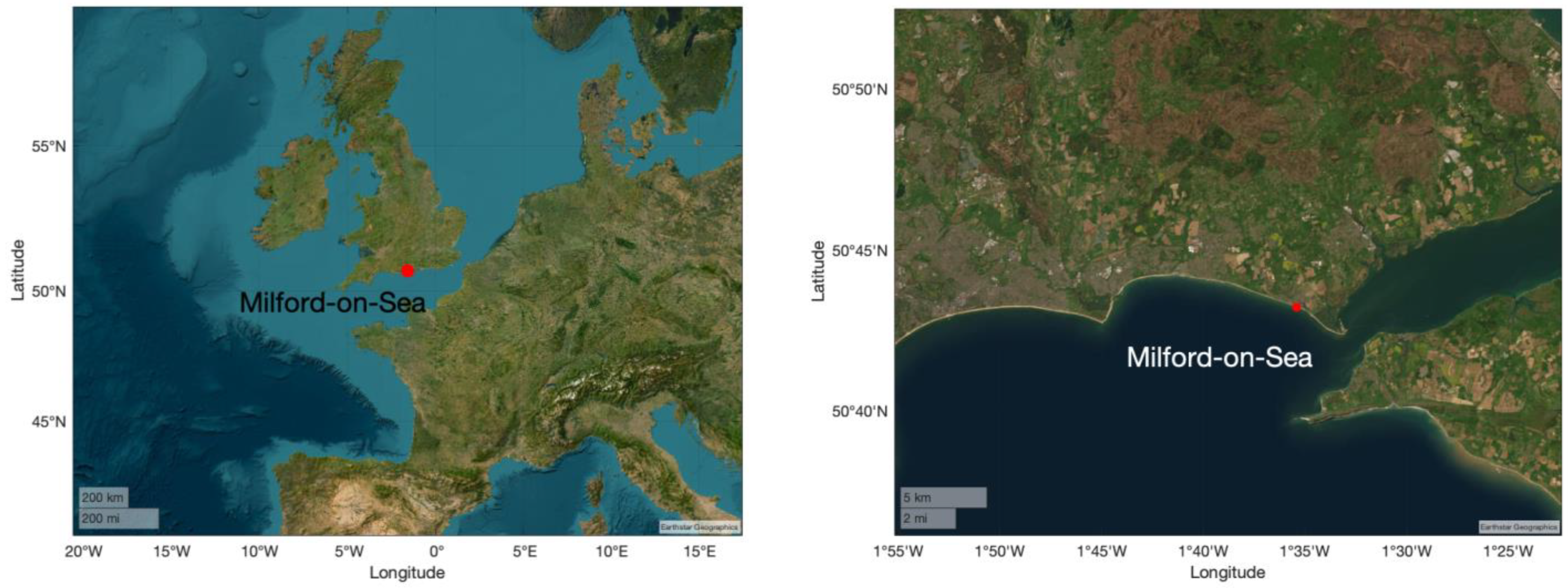


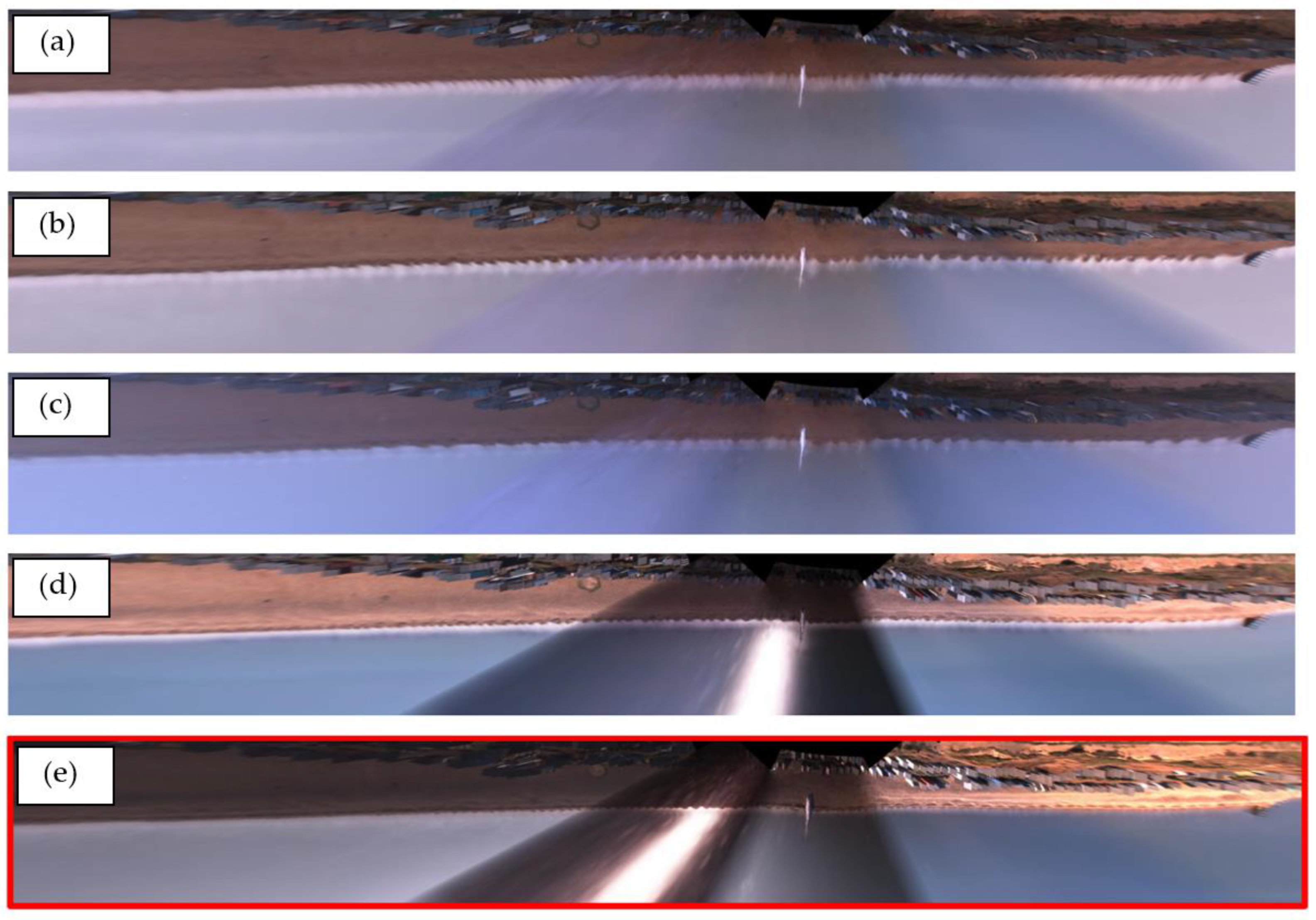
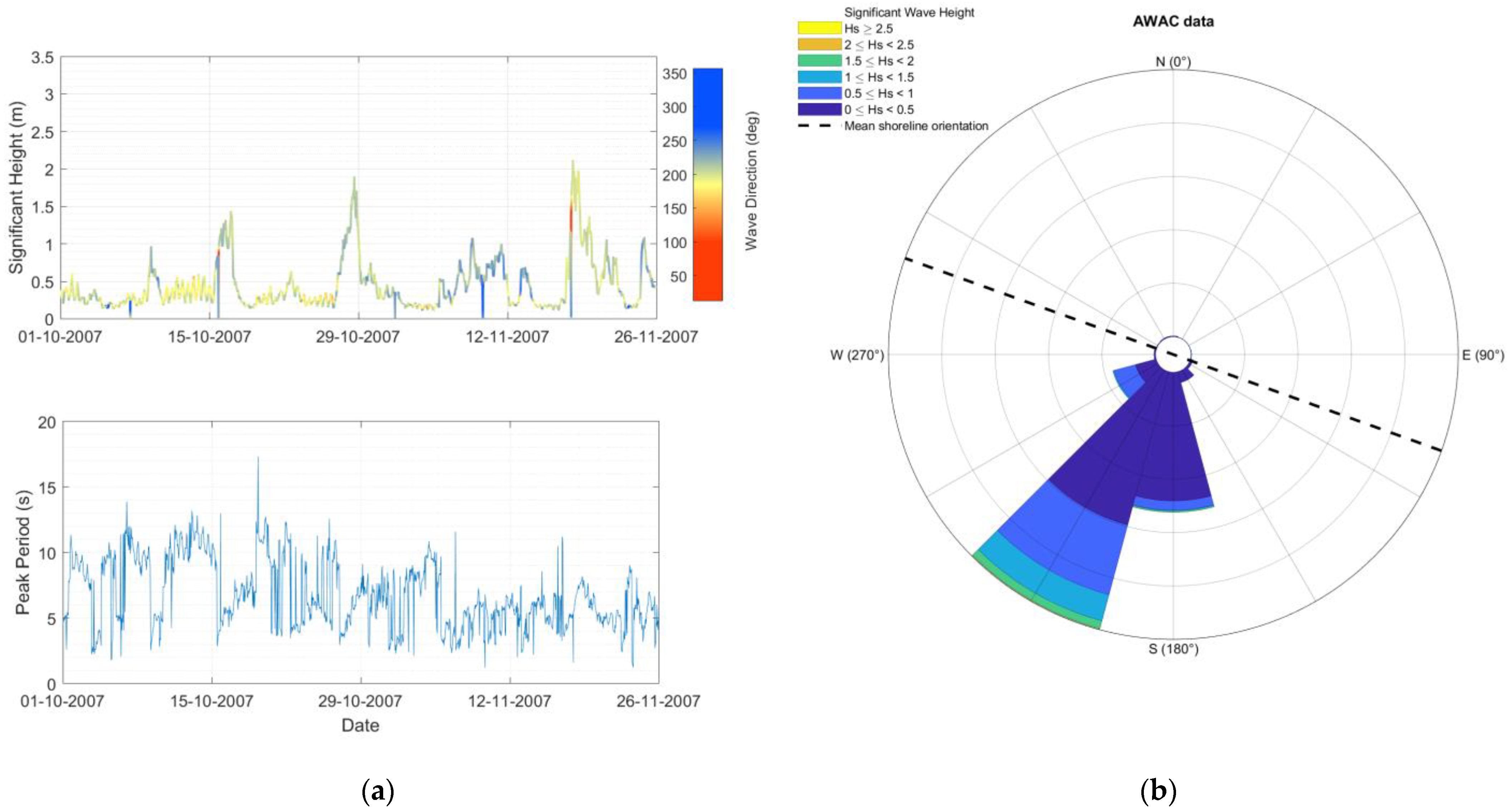

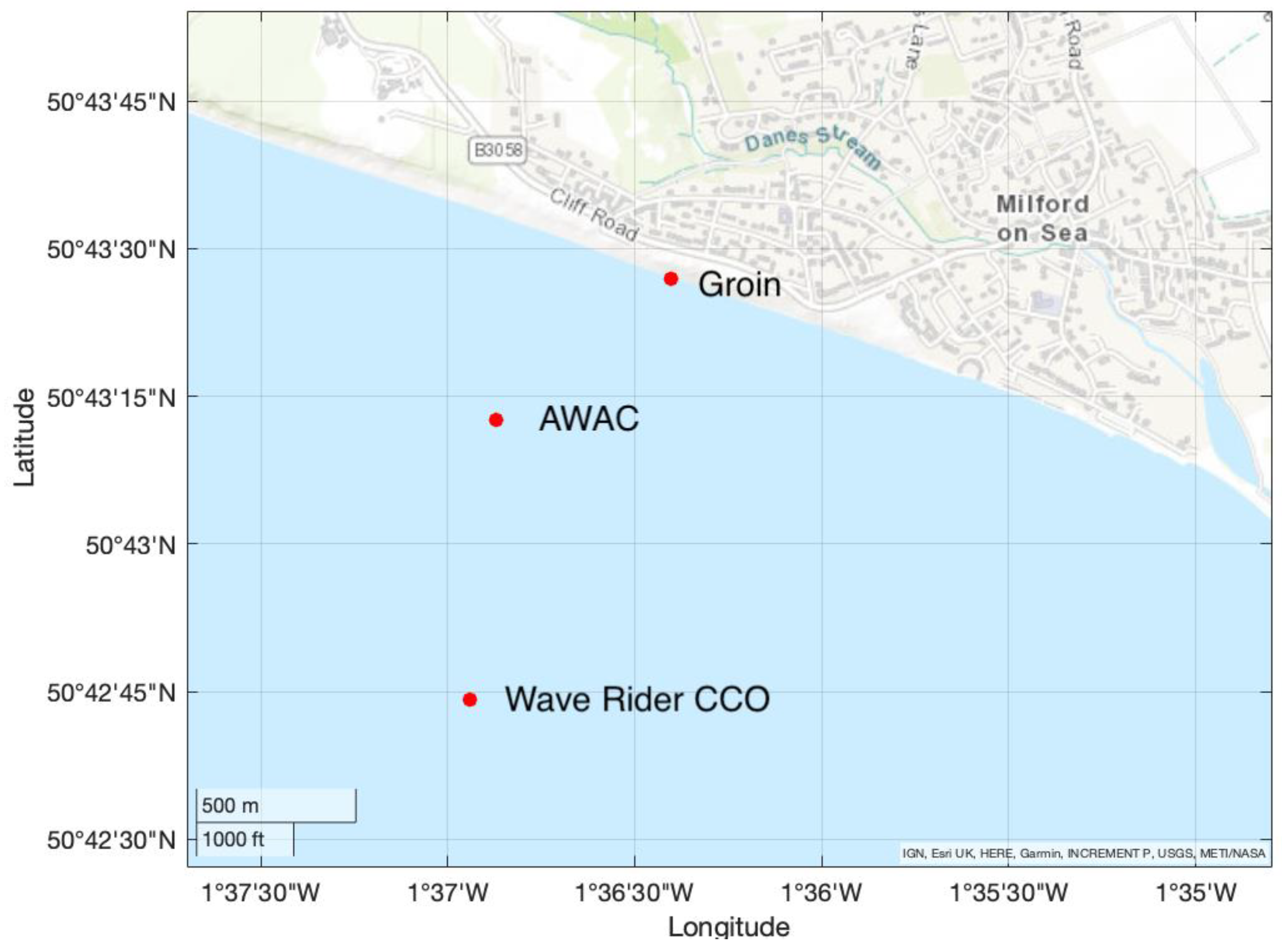

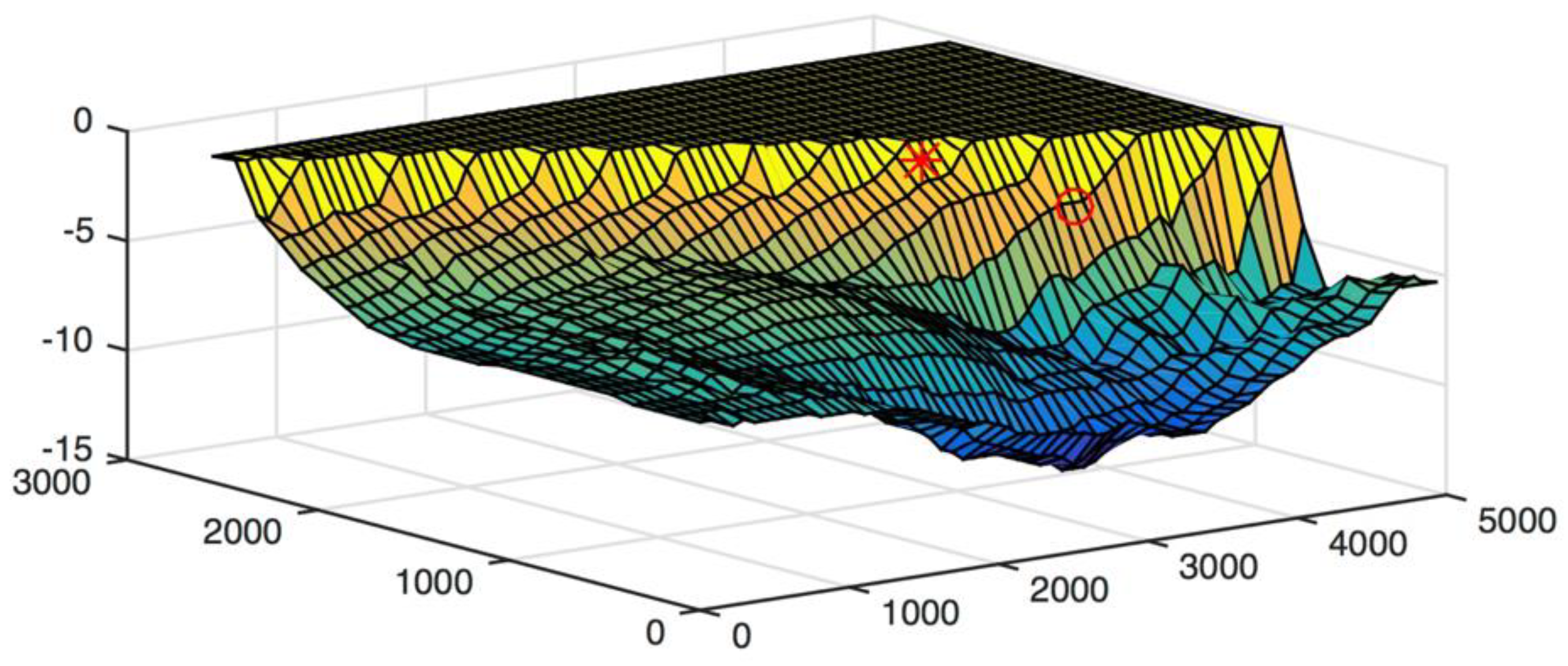
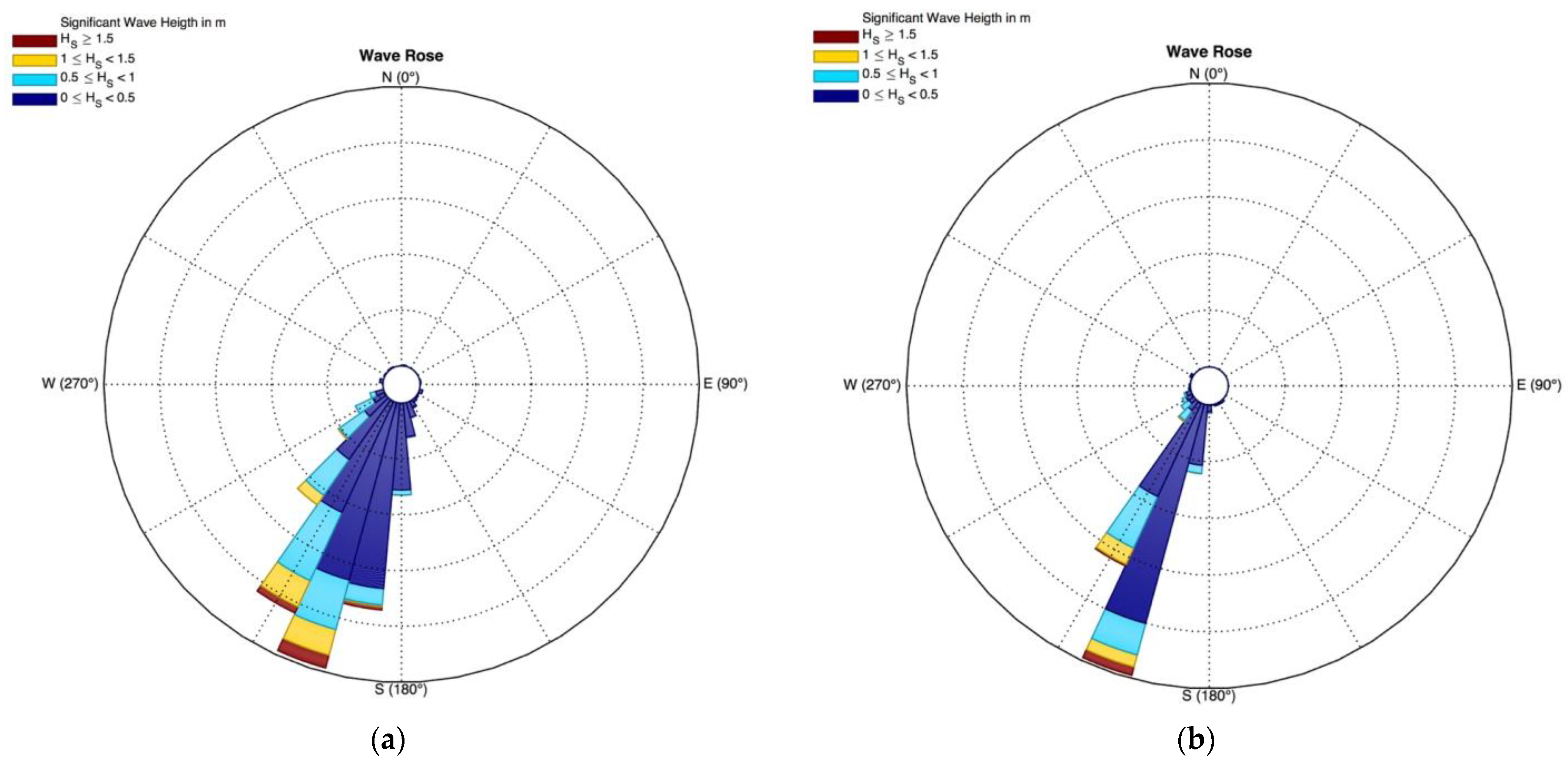
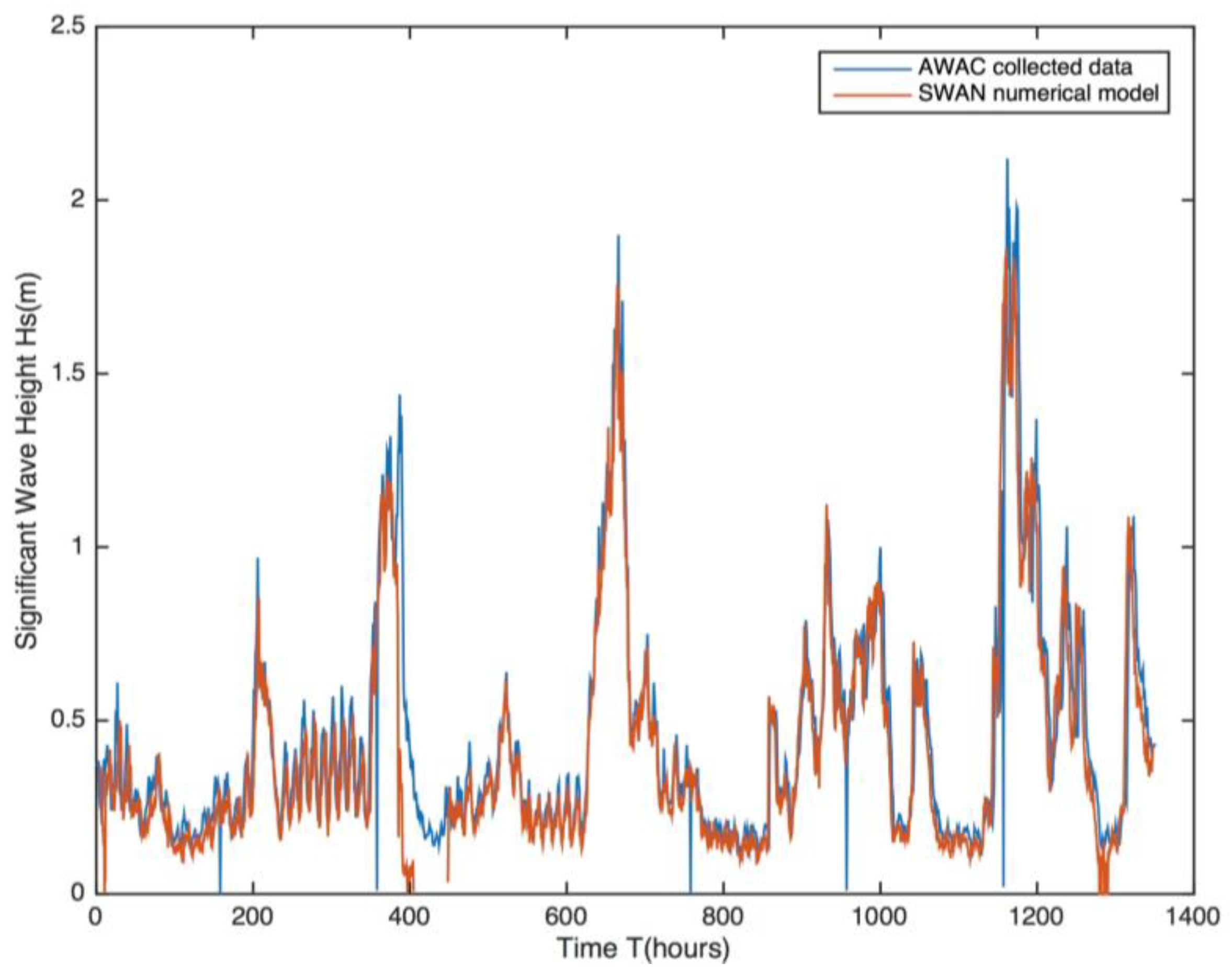
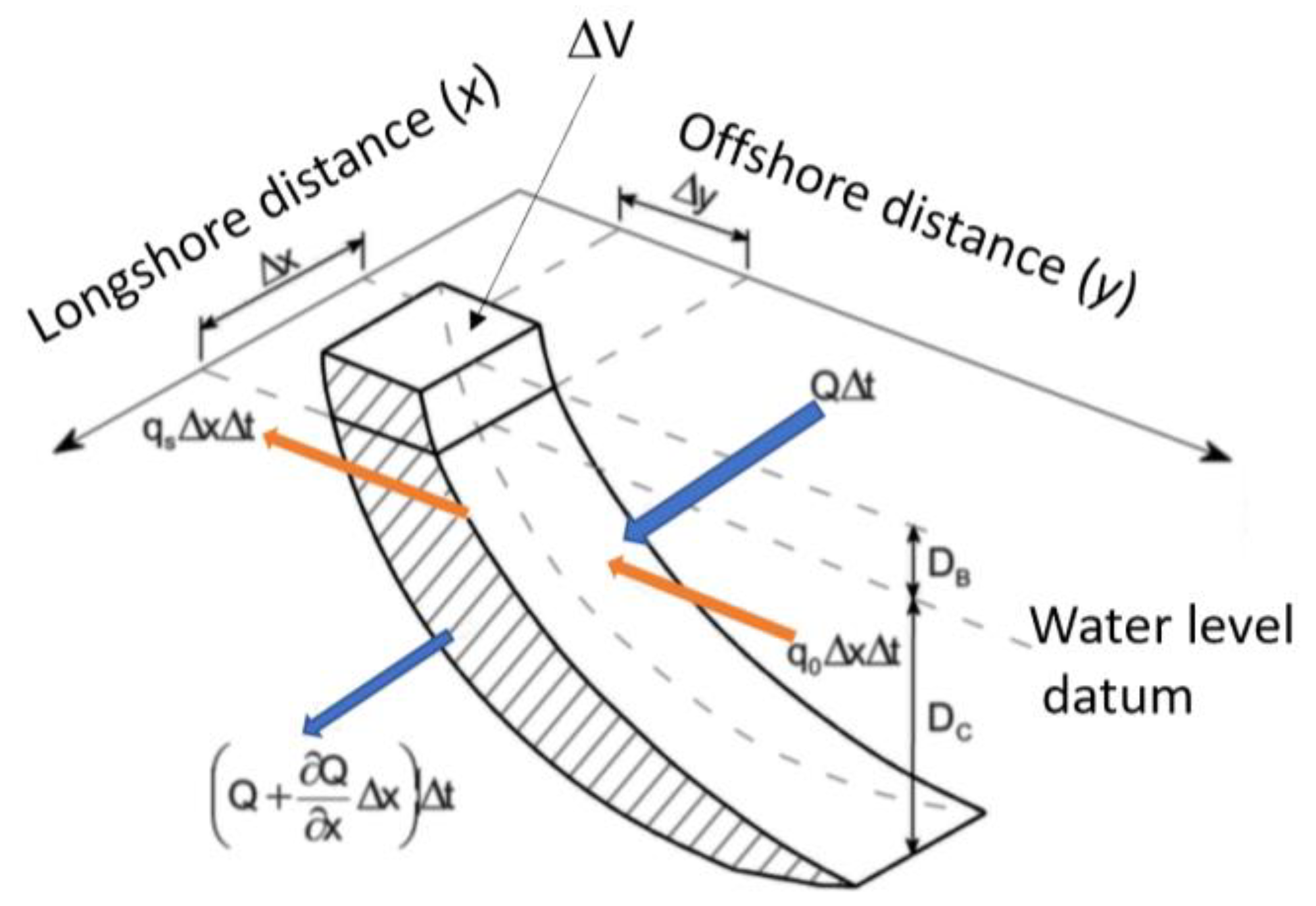
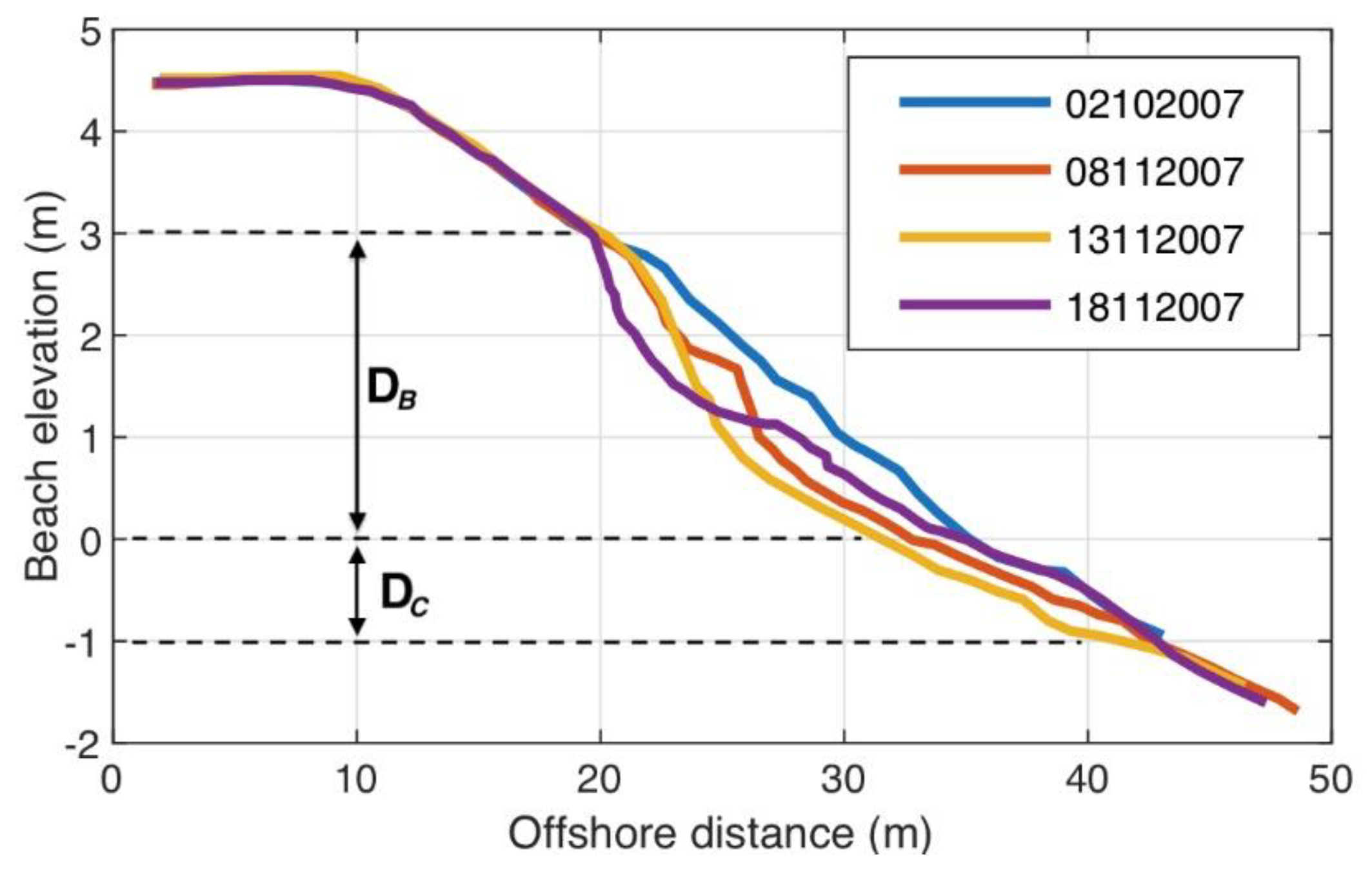
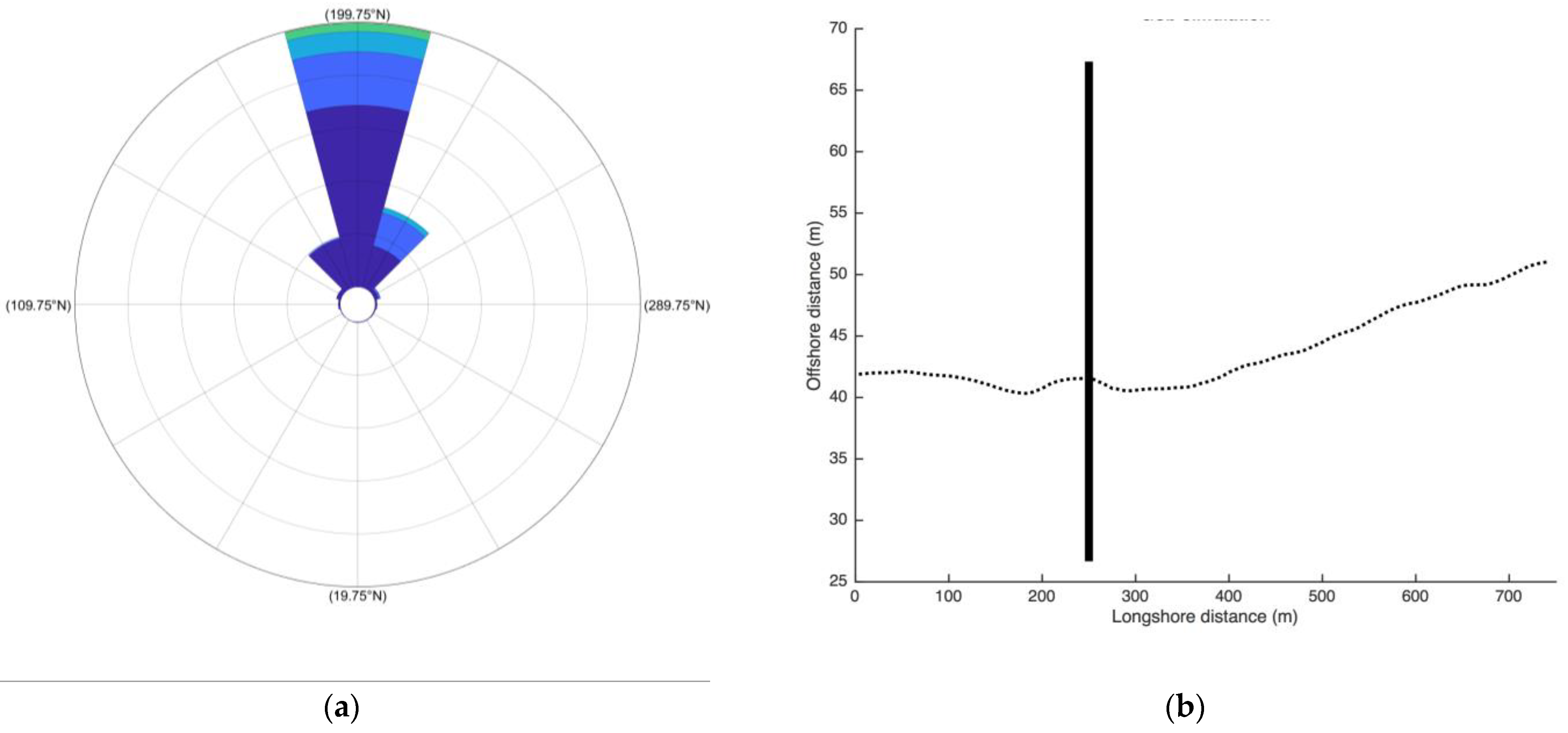
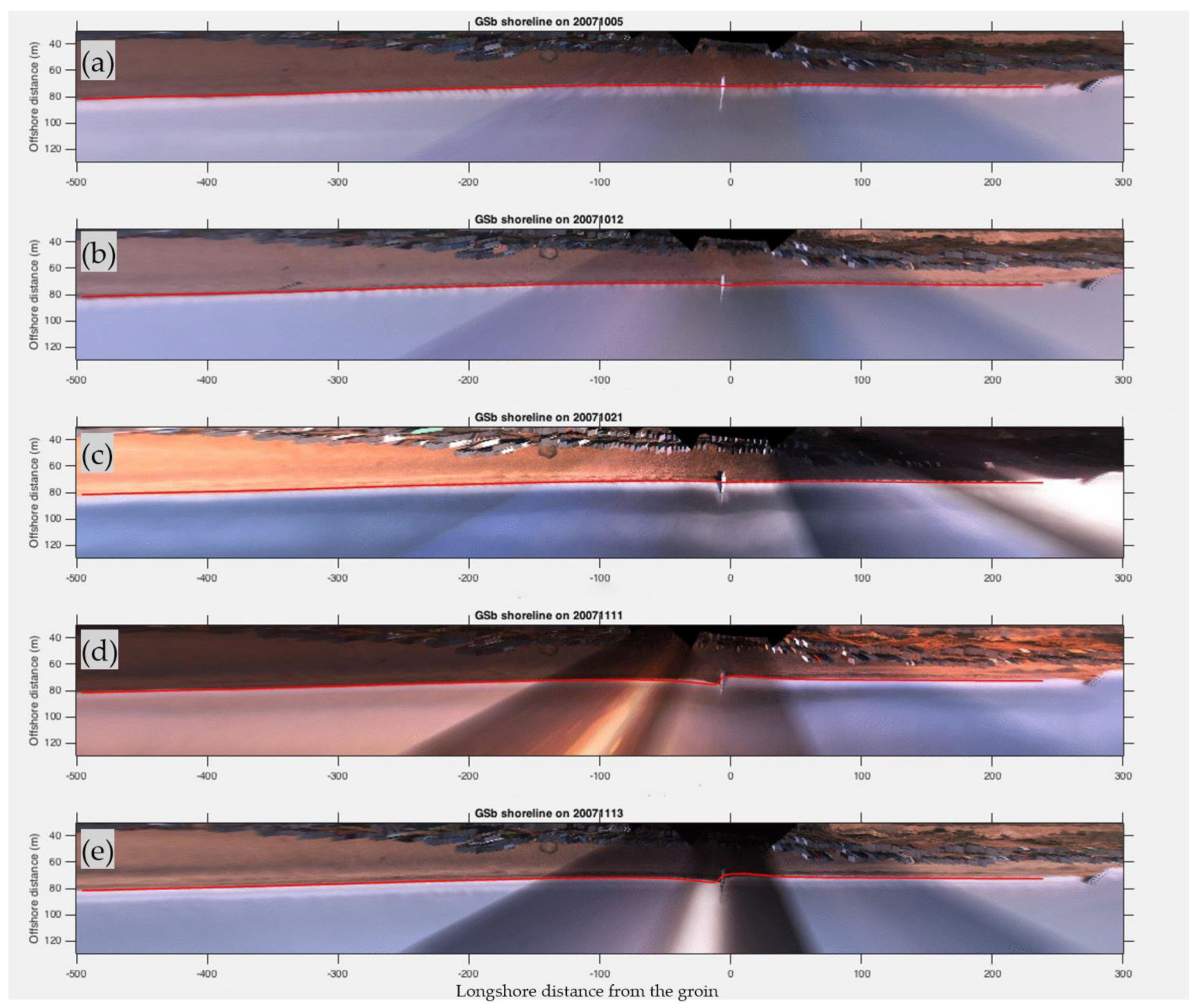
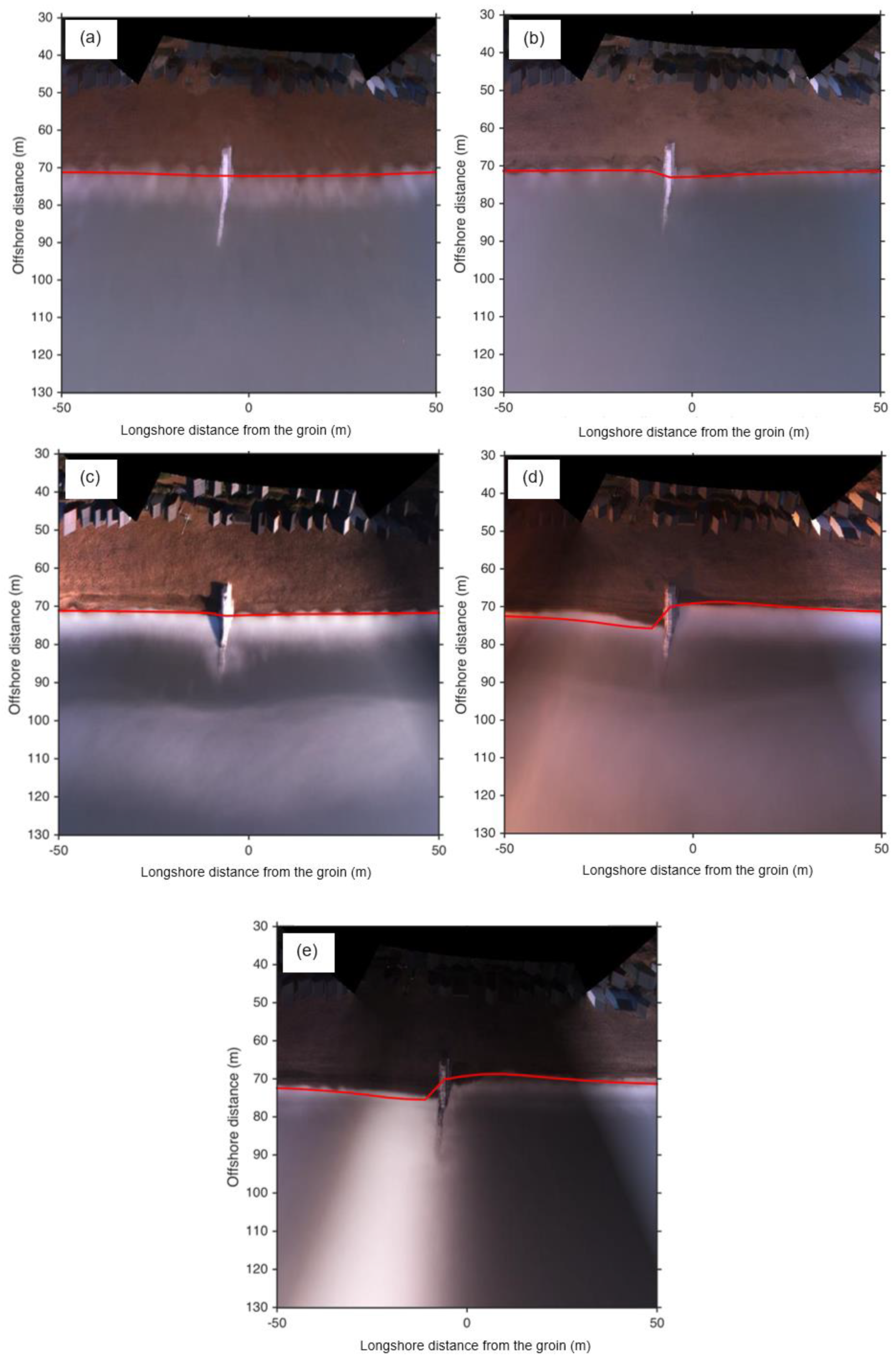
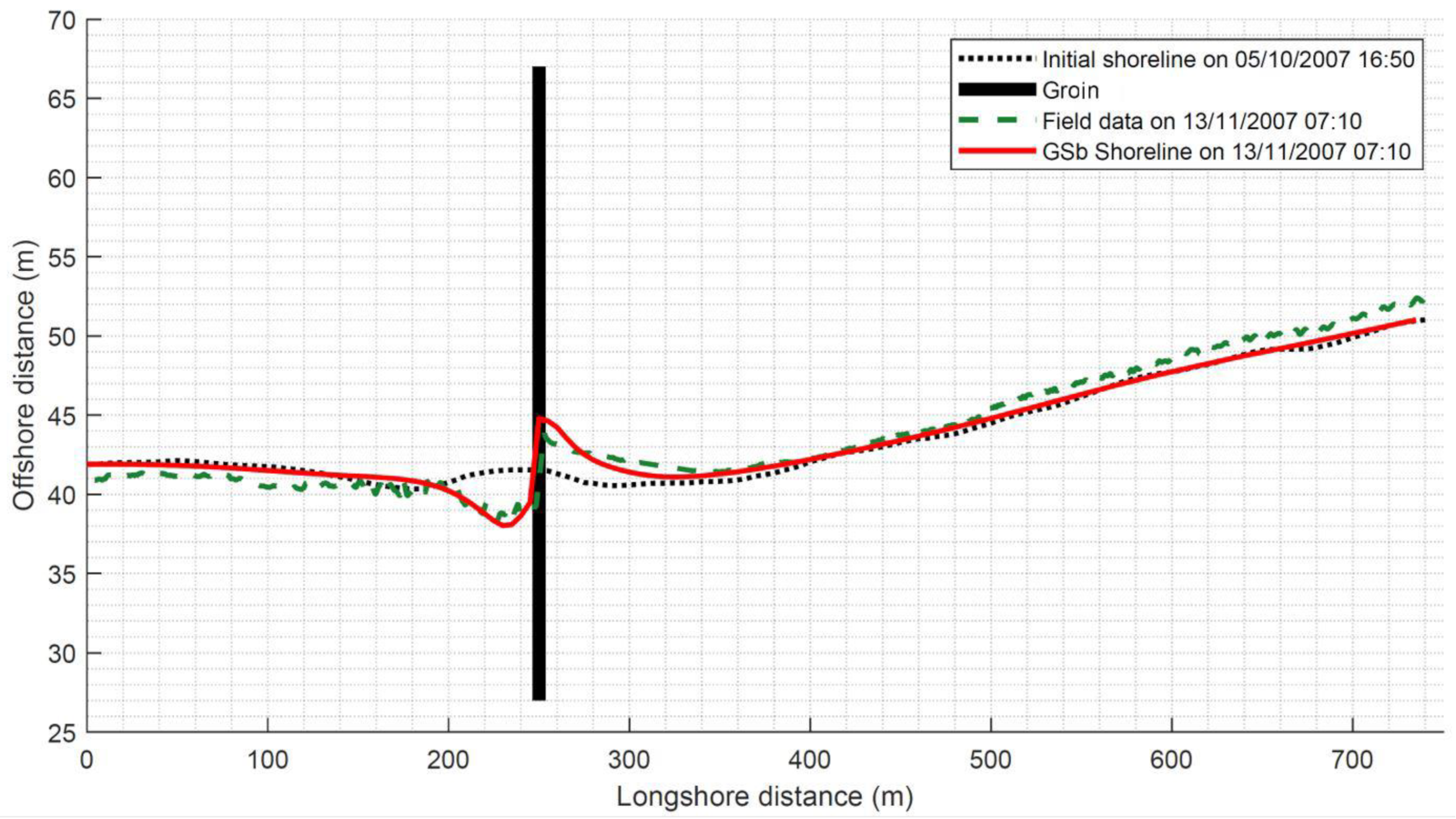
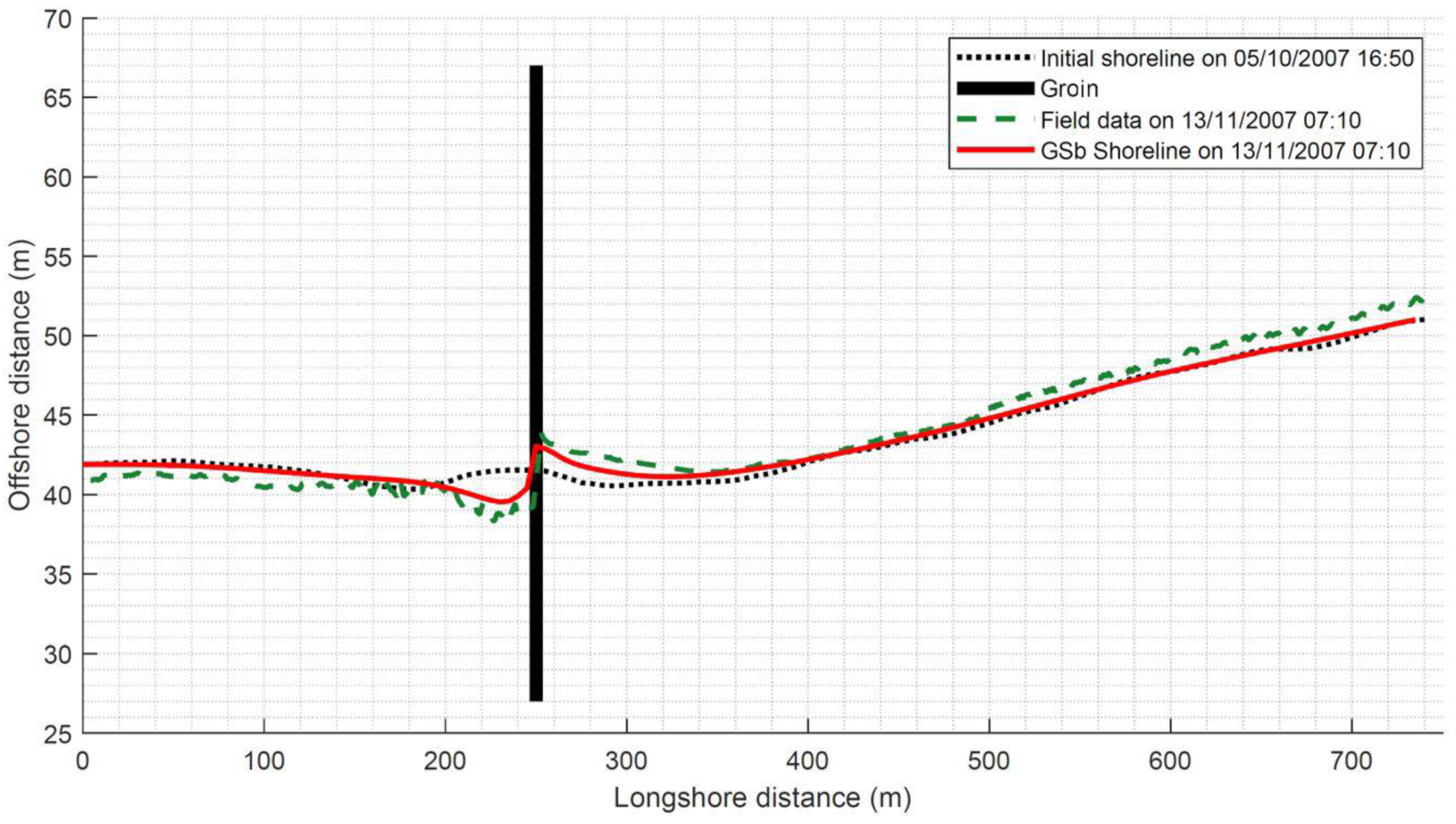
| Parameter | Value |
|---|---|
| n. row | 23 |
| n. columns | 68 |
| Cell size (°) | 0.001041667 |
| Cell size x (m) | 73.577 |
| Cell size y (m) | 115.878 |
| x-direction grid length (m) | 4929.664 |
| y-direction grid length (m) | 2549.318 |
| origin axis coordinate | 50.710 N, −1.655 E |
Disclaimer/Publisher’s Note: The statements, opinions and data contained in all publications are solely those of the individual author(s) and contributor(s) and not of MDPI and/or the editor(s). MDPI and/or the editor(s) disclaim responsibility for any injury to people or property resulting from any ideas, methods, instructions or products referred to in the content. |
© 2023 by the authors. Licensee MDPI, Basel, Switzerland. This article is an open access article distributed under the terms and conditions of the Creative Commons Attribution (CC BY) license (https://creativecommons.org/licenses/by/4.0/).
Share and Cite
Francone, A.; Simmonds, D.J. Assessing the Reliability of a New One-Line Model for Predicting Shoreline Evolution with Impoundment Field Experiment Data. J. Mar. Sci. Eng. 2023, 11, 1037. https://doi.org/10.3390/jmse11051037
Francone A, Simmonds DJ. Assessing the Reliability of a New One-Line Model for Predicting Shoreline Evolution with Impoundment Field Experiment Data. Journal of Marine Science and Engineering. 2023; 11(5):1037. https://doi.org/10.3390/jmse11051037
Chicago/Turabian StyleFrancone, Antonio, and David J. Simmonds. 2023. "Assessing the Reliability of a New One-Line Model for Predicting Shoreline Evolution with Impoundment Field Experiment Data" Journal of Marine Science and Engineering 11, no. 5: 1037. https://doi.org/10.3390/jmse11051037
APA StyleFrancone, A., & Simmonds, D. J. (2023). Assessing the Reliability of a New One-Line Model for Predicting Shoreline Evolution with Impoundment Field Experiment Data. Journal of Marine Science and Engineering, 11(5), 1037. https://doi.org/10.3390/jmse11051037







